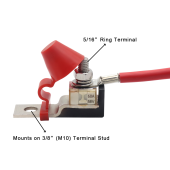The main issue here is not physically supporting the fuse, but anchoring the ends of the often massively thick and heavy cables going to the fuse.
To change the fuse, you just remove a couple of nuts, swap out the fuse then back into operation.
The cartridge fuse itself is designed to contain all the fire and explosive fury within, no need for any additional enclosure to protect nearby parts.
These standoff insulators are parts DESIGNED for high voltage heavy duty electrical applications. That is what they are for. They meet all the statutory requirements for electrical insulation and flammability, so in that respect are at least equal to a purpose built fuse holder.
The theory of using electrical lugs, is that the bolt must not carry the current, it merely provides clamping force to compress the copper parts and hold them very securely together. High tensile steel bolts are ideal for that function. The electrical current then flows directly between the copper parts.
I would not bolt one end of a fuse directly onto one of the battery terminals, any movement applies stresses the parts were not designed for.
Much better to bolt the standoff insulators to a rigid part of the metal battery frame, in a readily accessible location, and use a short length of flexible wiring between the last battery terminal and the fuse. Its also then possible to locate the fuse where metal tools are less likely to cause any shorts to ground when replacing the fuse.
Its not rocket science, but any electrical inspector will be looking for obvious points of danger, or potential failure. If its a well thought out, neat, and practical installation, the inspector is more likely to appreciate the thought and effort that went into it.




